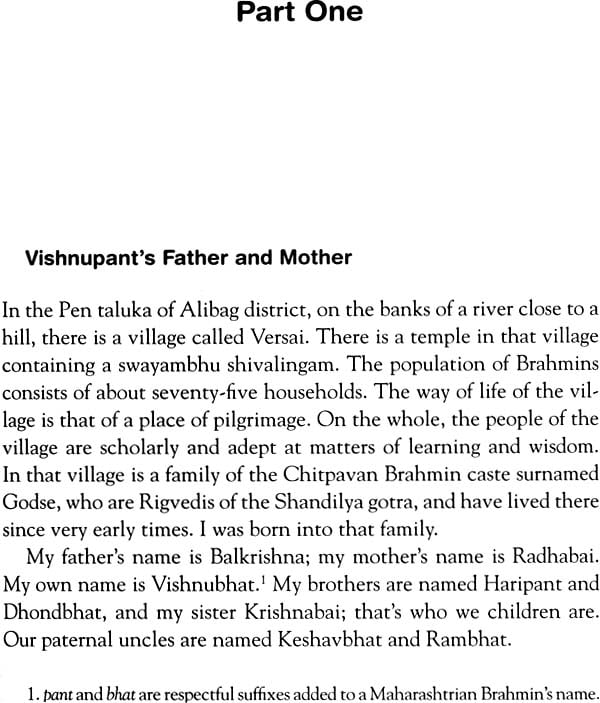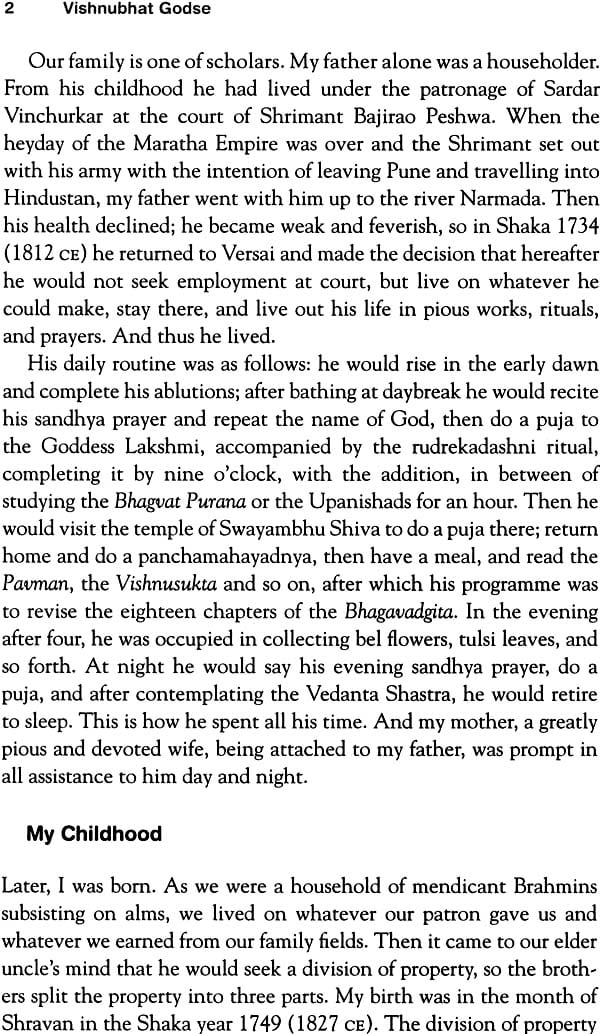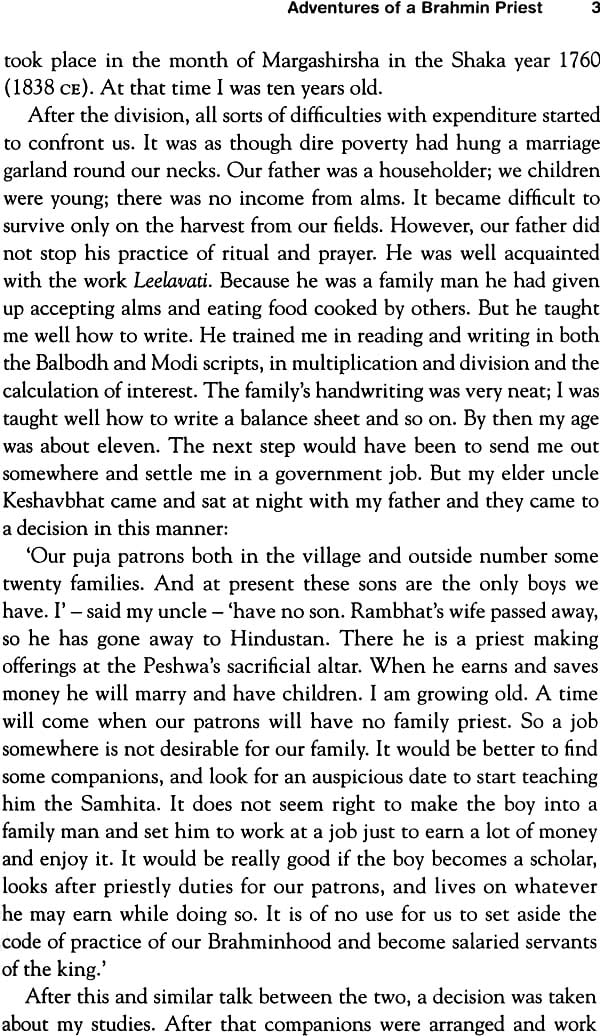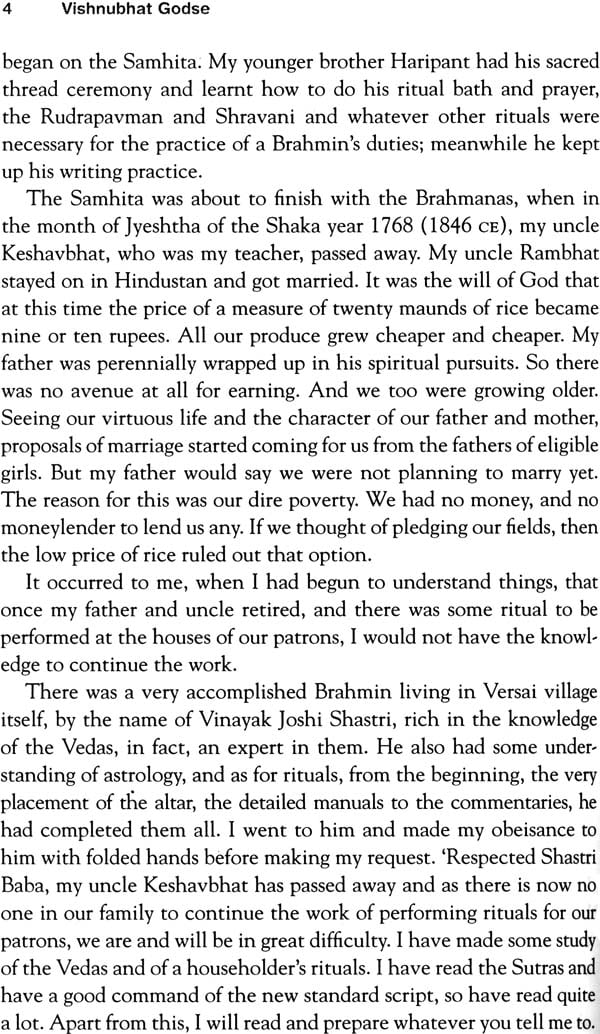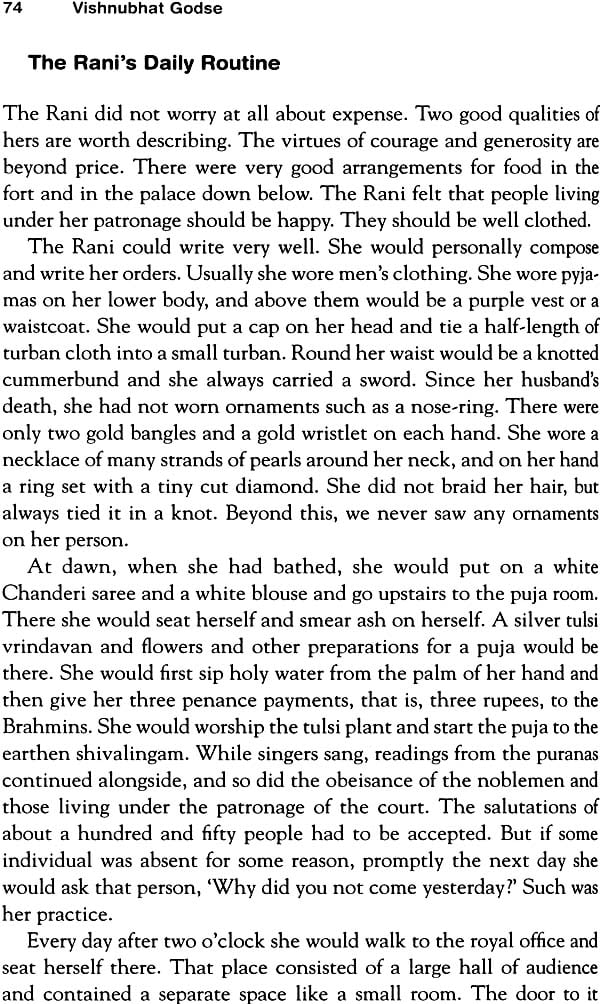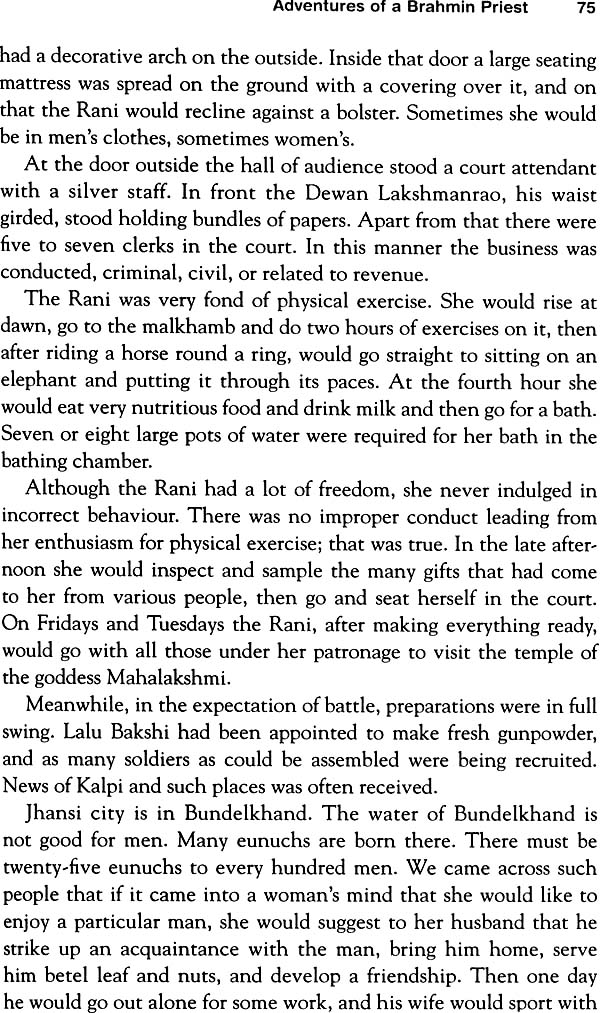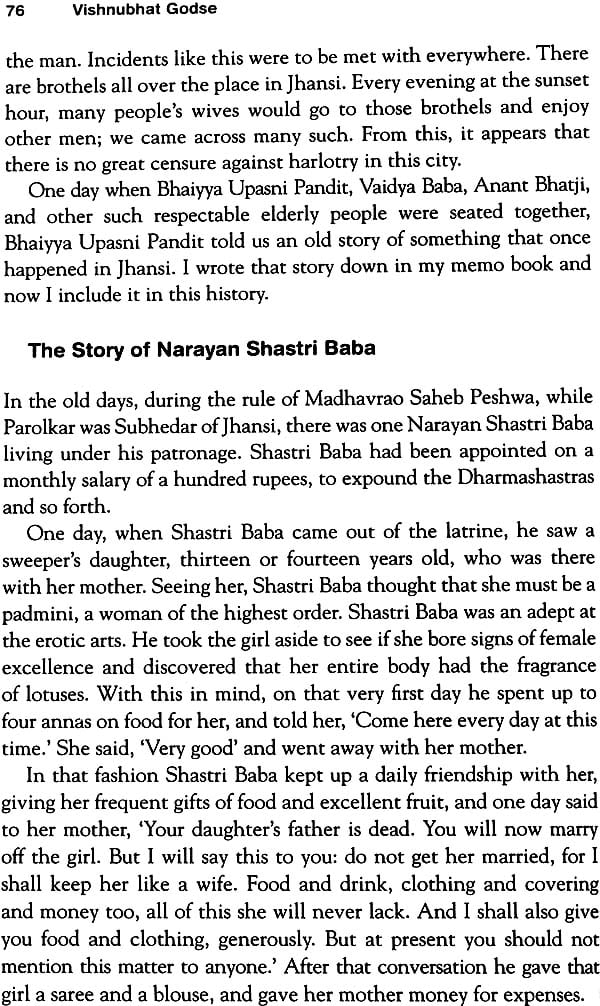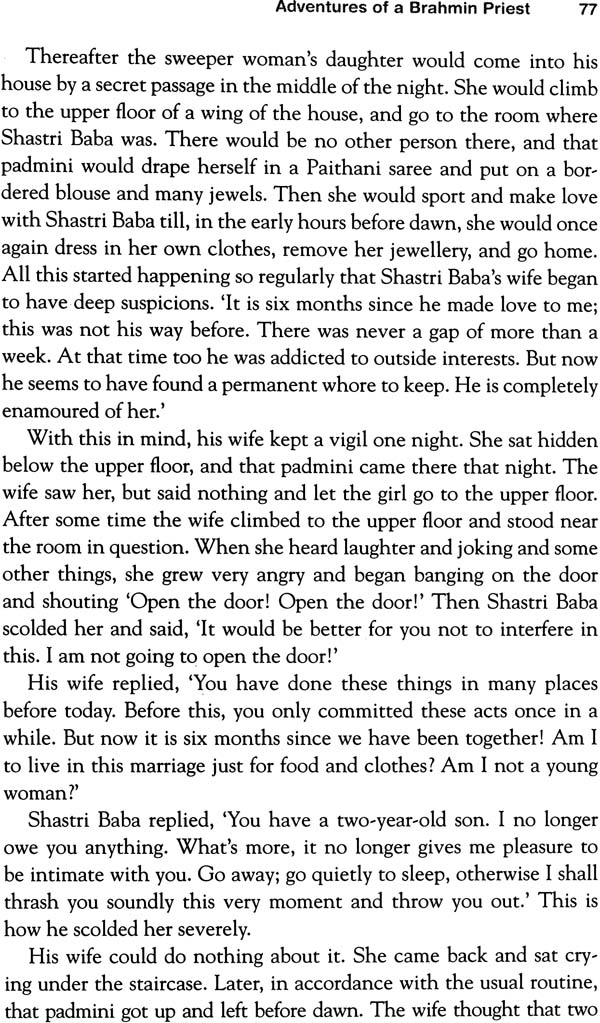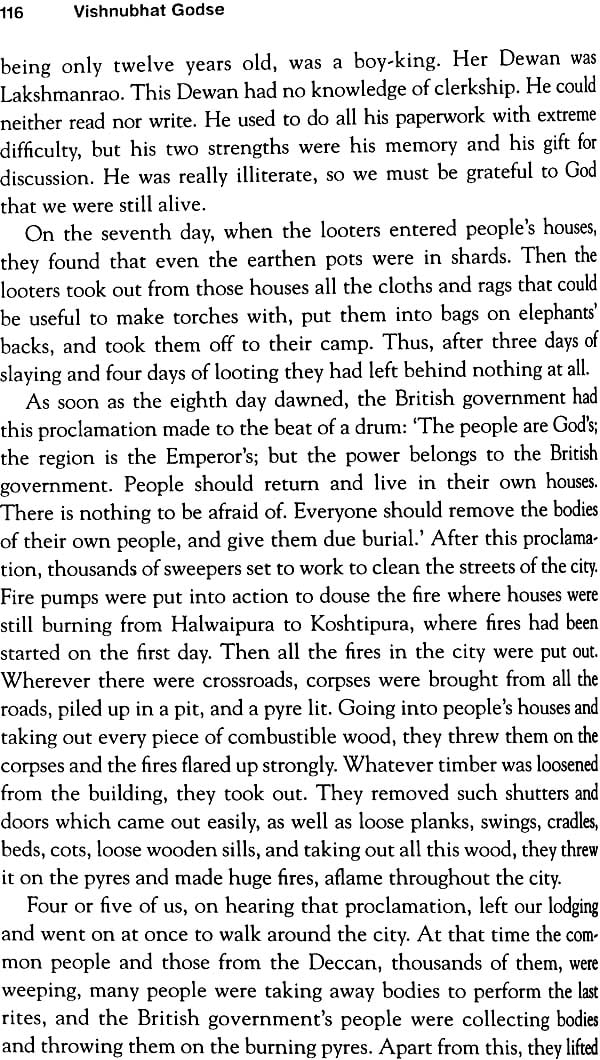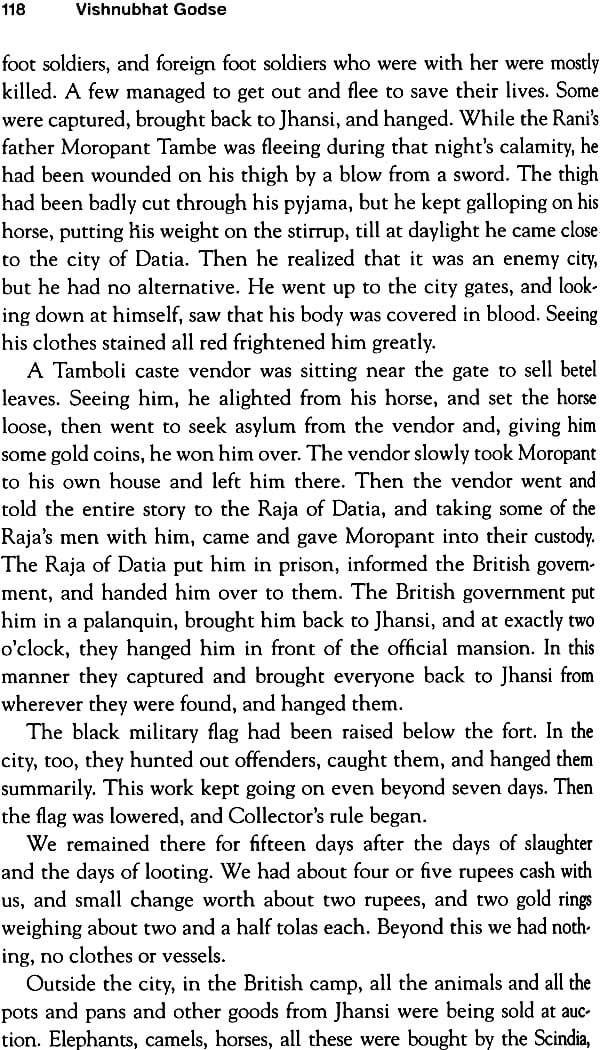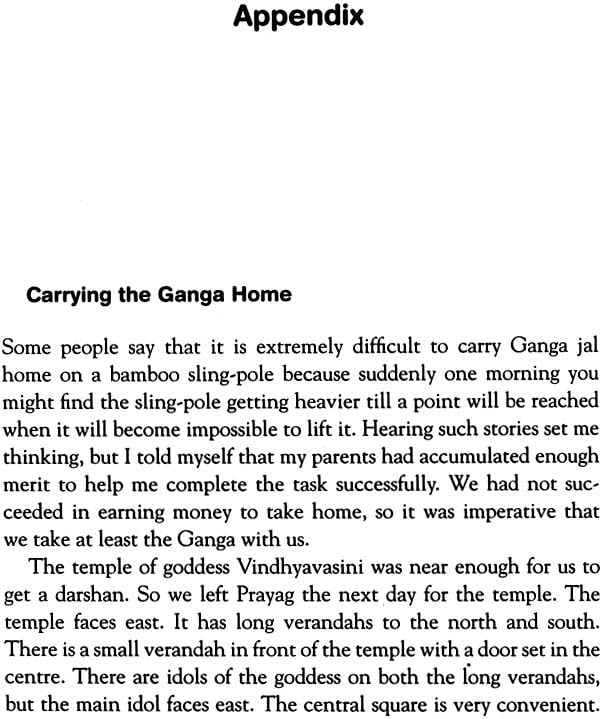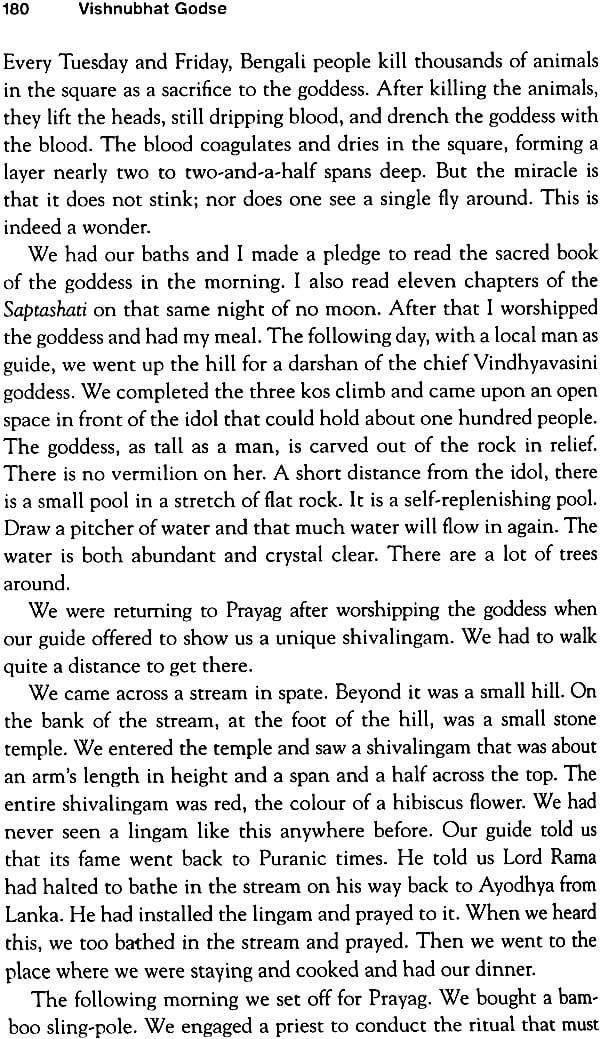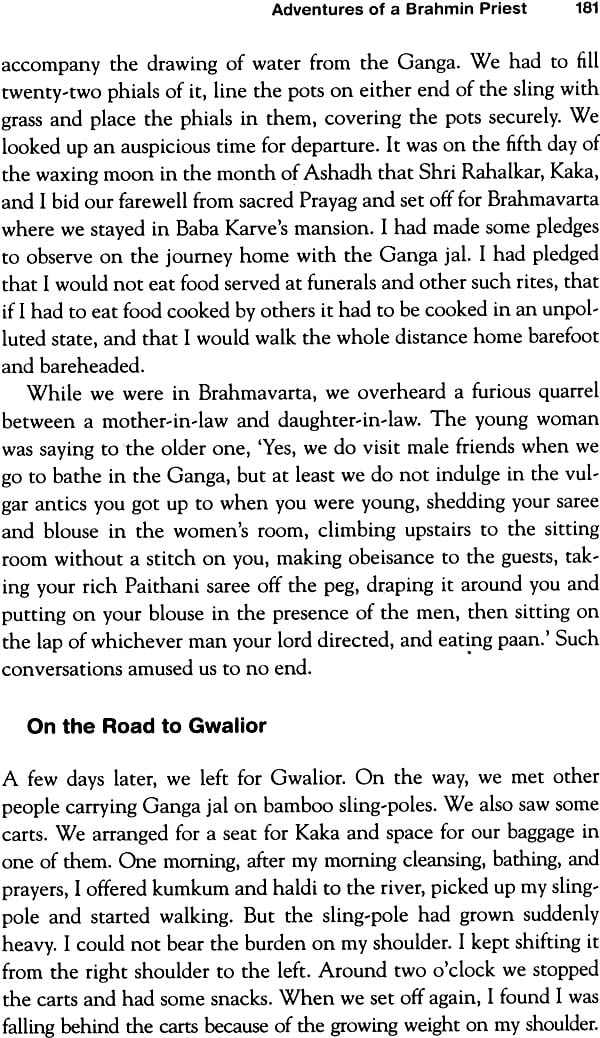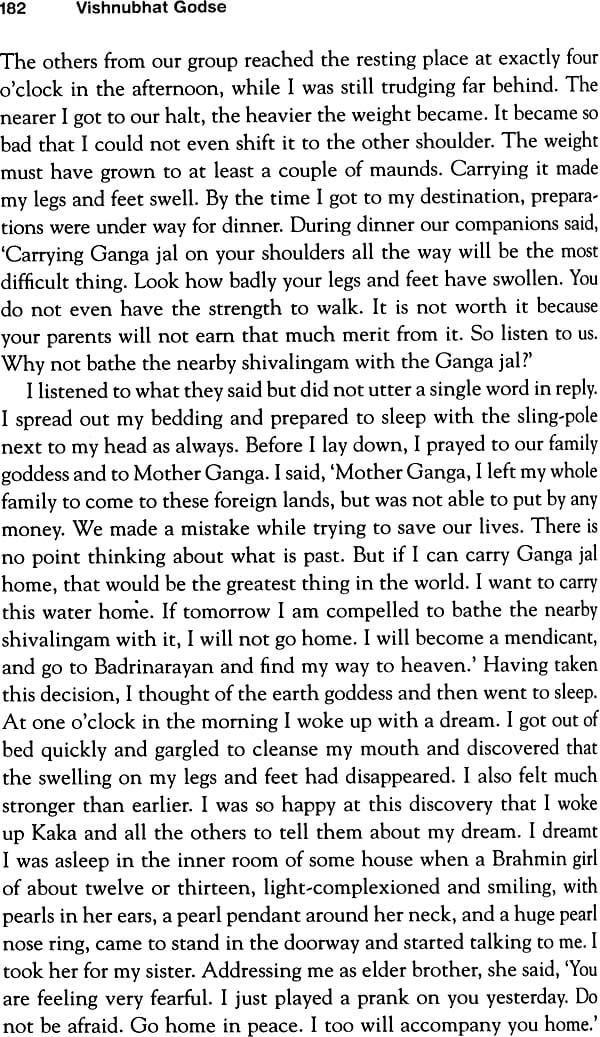
Adventures of a Brahmin Priest (My Travels in The 1857 Rebellion)
Book Specification
| Item Code: | NAL605 |
| Author: | Vishnubhat Godse |
| Publisher: | Oxford University Press, New Delhi |
| Language: | English |
| Edition: | 2015 |
| ISBN: | 9780198098904 |
| Pages: | 259 |
| Cover: | Paperback |
| Other Details | 8.5 inch x 5.5 inch |
| Weight | 280 gm |
Book Description
A journey to north India in 1857 to mend theirfortunes and visit holy places leads a Brahmin priest, Vishnubhat Godse, and his uncle straight into and through the conflict zones of the Great Uprising. Their travel turns into an adventure, a patchwork of pujas, court patronage, and miraculous escapes from fierce battles. Twenty-five years later; Vishnubhat Godse wrote Mazha Pravas. Literally, ‘my journey’, the narration uses nineteenth-century idiom as it describes rituals and prayer; bizarre cross-dressing, battle and blood, and, most memorably, the fall of Jhansi.
Straddling both historiography and literature, this Marathi classic published in 1907, interprets the Rebellion as a righteous one and pins its failure to a moral point: in killing women and children the rebels violated the Hindu code of ethics and thus ensured their defeat. This first Indian account of the Uprising is sprinkled with anecdotes and descriptions of courtly relationships. The narrative captures the fear and hysteria of palace intrigues, and above all, the valour of Rani Lakshmlbai.
Vishnubhat Godse was born in 1837 in a small village in Maharashtra, into a family of pious Brahmins. In early 1857, he set out with his uncle to earn enough money to clear his family's debts by performing priestly rituals in courts across northern India. Very soon, the pair was caught up in the battles and upheavals of the 1857 uprising, and their travel became a patchwork of pujas, court patronage, and sudden flight from fierce battles. Godse recorded his experiences during the 1857 Rebellion twenty-five years after his return, but instructed his family to publish the work only after his death. His is the first Indian-language account of the 1857 Uprising.
Vishnubhat Godse of Versai village wrote his account of the 1857 Rebellion twenty-five years after he witnessed the events. His memory of them could not have been very clear by then, but it is possible to say from evidence that he had made notes to aid his memory. Godse Bhatji actually spent some time in the employ of Lakshmibai, the Rani of Jhansi. He personally witnessed and experienced the events he has recorded as they occurred in Jhansi. He witnessed some events in other places too. He had left home with the hope of earning some money for his family, and got caught in the wildfire of the Rebellion. With his hopes of earning money dashed, he decided that he would at least earn merit by undertaking a pilgrimage. He suffered many hardships in doing so and returned home two-and-a-half years later.
Godse Bhatji met many companions along the way. He gleaned information about events from them too. The chronicle he wrote later was based on first-hand experiences and second-hand accounts. Chintamanrao Vaidya states that it was he who asked Godse Bhatji to write his memoirs. Godse Bhatji's son, Narharshastri, lived in Madhav Baug in Bombay where he gave discourses on the Gita. I had attended one of them with my friend Shri N.R. Phatak. It does not appear that Godse Bhatji wrote his chronicle at Chintamanrao's prompting. Others too must have urged him to do so, and he himself clearly wished to write it. Be that as it may, we have reproduced here Shri Vaidya's handwritten letter that was attached to the manuscript when he handed it over to the Bharat Itihas Sanshodhan Mandal. At present no relatives of Godse Bhatji live in Versai. Other people like the Rahalkars and Oaks have also left the village. Shri Rahalkar appears in the chronicle as someone who went on the same pilgrimage after Godse Bhatji and returned to Versai before him. Others who had also gone north for their own work were Shri Chandorkar, Shri Jahagirdar, and Shri Hingne. They had met Godse Bhatji at different points. Some people from Versai had settled in the north. Godse Bhatji gives an account of his meetings with them. It would be worth making an attempt to discover whether any of them possesses notes or letters written by him.
When Chintamanrao published this chronicle, not a single such account of the Rebellion was known to have been written by an Indian. However, I was a member of the committee that the Indian Government constituted to gather materials on the history of Independence. It was during this time that we discovered that one Mr Belsare from Nagar district had written an eyewitness account, many years after he had found himself caught in the events of the latter part of the Rebellion when Tatya Tope was fighting a guerrilla war against the British. We obtained a copy of the manuscript from his son and the government published it. That manuscript, like Godse Bhatji's, was written in the Modi script. People had been so terrified by the events of the 1857 Rebellion, that until Veer Savarkar wrote his book, The 1857 Struggle for Independence to bring before the world the history of the Rebellion written from the perspective of Independence, nobody, with the exception of a few outspoken Britishers, had dared to connect the Rebellion with our struggle for Independence. No Indian could openly speak in praise of the Rebellion. It would therefore not be wrong to infer that Godse and Belsare must have written their chronicles guardedly and mildly.
Neither of the two gentlemen was a writer. They were not used to writing in refined language. We must therefore not pay attention to their language but to the contents of their chronicles.
The practice of writing chronicles about past events existed in these parts in the olden days. Several chronicles like Bhausaheb's [Mahikavatichi Bakhar] are beautified by literary merit. The later Harivansh chronicle is also immensely readable. However, there were hardly any writings in prose in Marathi till the present times. With the coming of the British, Marathi acquired both a grammar and a dictionary. School textbooks were prepared. Newspapers and magazines began to be published. The language that was used in those times and the lithographic printing do not give us the reading pleasure that we have today, when Marathi has found a form that is finely defined and structured.
Vishnubhat Godse was born in the Shaka year 1749 (1827 CE), in the first years of British rule. He was over fifty years old when he wrote this chronicle. Chiplunkar's series of essays had already stirred the reading world and he had long since passed on. The Marathi language had acquired prestige. Yet, Vishnubhat does not write in the new way. There is merit in having published this book in the style of language in which Vishnubhat wrote it.
Much literature about the 1857 Rebellion has been published now. The governments of the United Provinces, Bombay, and Hyderabad have published volumes containing copious information. However, there is not a single volume amongst them like Godse's and Belsare's, which are eyewitness accounts, written about the events by individuals unconnected with the government. Dr Vishram Ramji Ghole of Pune was in the health department of the British government during the siege of Jhansi. Such a person could have certainly recorded his experiences of the time. It is regrettable that this did not happen. Considered from all these angles, Godse Bhatji's chronicle is unique. The late Chintamanrao Vaidya must be thanked for keeping the manuscript so carefully for many years, handing it over for safekeeping to the BISM* and publishing it twenty-five years after it was written.
In the foreword to the edition he published, he has said that he had made a very few changes in the original manuscript. 'I have improved the language here and there and followed today's spelling and punctuation. In some places I have cut out parts which struck me as being overwritten. There are only two places in which I have added some lines of my own but they are in keeping with the original writing. On the whole, it would be right to say that this is the original edition'.
When the second edition of the book was being published (1948), my scholar friend Shri N .R. Phatak was given the responsibility of editing it. Tallying the original manuscript, which Shri Vaidya had handed over to the Bharat Itihas Sanshodhan Mandal, with the edition published by Shri Vaidya, Shri Phatak noted, 'In many places, there are major differences between the original manuscript and the published edition. One begins to doubt Shri Chintamanrao Vaidya's claim of having been faithful to the original. That is why the original manuscript must be published exactly as it is at some future date' (Preface page 21, August 1961).
Clearly, Godse Bhatji's book had to be brought before the world at some point of time in its original form. That is why we take pleasure in presenting to the curious, this edition, which is the original manuscript, with nothing cut or added. Godse Bhatj i's manuscript has been written in the Modi script. His handwriting is legible and the chronicle has been written at one go. He has inscribed his name, Versaikar Vishnubhat Godse at the end of each part. Godse was Chintamanrao's family priest; so when Chintamanrao says that the manuscript was written by Godse, there is no reason to disbelieve him. It is important to state here categorically that not a single line in the manuscript has been changed in this edition.
Godse has divided his narrative into six parts. The end of the sixth part is incomplete. It is followed by an appendix, which he ends with his homecoming. He states that with this his narrative is complete. Although we cannot determine whether this is a continuation of Part Six or an independent Part Seven, it is certain that it is the end of his narrative. We have printed the narrative exactly as we found it. The few lines that appear separately at the end of Part Six were found attached to the main manuscript on a scrap of paper. The scrap of paper is cut at the bottom. We cannot make any further conjectures about the incompleteness of Part Six. The manuscript we received comprised two bound notebooks, one scrap of paper, one separate sheet and six Appendix sheets. We have taken care to have all these separate parts of the manuscript printed and published exactly as they are.
We would now like to draw the readers' attention to the following points regarding the transliteration of the original Modi script of the narrative into our Balbodh script.
1. Modi is written in a straight unbroken line with no spaces between words or sentences. We have broken up the sentences .
2. In the old days, even the Balbodh script was written without any punctuation except for vertical strokes at the end of some lines. However, Godse has used a certain amount of punctuation in places. In this edition we have used appropriate punctuation throughout.
3. The Modi script does not have separate signs for long and short vowels. We have used long and short vowels according to our best understanding.
4. There is no rigid rule regarding dots signifying nasal sounds in the Modi script. Writers were apt to put a dot wherever they pleased. In Godse's manuscript, we found many places where the nasal dot had been used without reason and other places where it had been used correctly. We have added the dot where it was missing and deleted it where it was used erroneously.
It would be obvious to the reader that such changes do not interfere in any way with the contents of the original.
Godse has divided his chronicle into six parts. He has not made paragraphs with every new shift in the subject matter as we do in modern times, nor has he numbered the pages. In this edition we have made a paragraph whenever there is a change of subject and subtitled the new section according to its contents. The subtitles are not Godse's. Similarly, we have given titles to each of the six parts. The original manuscript bears titles like Part One or Part Six, but it does not bear subtitles that indicate the subject of that part. Even the title 'Additional Material' [Appendix] given to the last part is ours. The six supplementary sheets that are part of the manuscript form our 'Additional Material'.
Godse's manuscript came into the keeping of the BISM in 1922. It has taken forty-four years for it to appear in its original form before the public. Godse's chronicle is a valuable resource for linguistic, historical, and sociological study. The labour we have put into pre- paring this edition will be rewarded if it serves that purpose.
| Preface by Datto Vaman Potdar | ix |
| Chintamanrao Vaidya's Letter | xv |
| Translators' Notes | xix |
| Introduction by Prachi Deshpande | xxix |
| Part One | 1 |
| Vishnupant's Father and Mother | 1 |
| My Childhood | 2 |
| Starting Studies and My Wedding | 5 |
| The Weddings of Haripant and Krishnabai | 6 |
| Like Rama, Lakshmana, and Bharata | 7 |
| Baizabai Scindia and the Sarvatomukh Yadnya | 8 |
| Our Resolve to Travel, and Attendant Problems | 8 |
| My Father's Advice | 11 |
| At Last, the Day of Departure Dawns | 11 |
| Fond Family Farewells | 13 |
| The Fifth Waning Day of Phalgun, Shaka 1778 | 14 |
| Part Two | 15 |
| Onward from Wagholi | 15 |
| A Snake Bites the Yajurvedi Brahmin | 16 |
| Beautiful Satpuras | 17 |
| Warning Signs of Rebellion | 18 |
| The Affair of the Cartridges | 20 |
| The Tenth Day of june | 22 |
| The Mhow Camp is Set on Fire | 23 |
| We Reach Ujjain | 25 |
| At Vishnupant Joshi's Home | 26 |
| Pawar, Raja of Dharanagar | 27 |
| The Gifts at the Raja's Funeral . | 29 |
| Meeting Baizabai Scindia at Gwalior | 32 |
| Part Three | 35 |
| The Rani of Jhansi's Childhood | 35 |
| Gangadhar Baba | 37 |
| Chhabeli's Wedding | 39 |
| Departure for Jhansi | 40 |
| Tatya Tope | 40 |
| Keshavrao of Gulsarai: Attack and Arrest | 42 |
| Tatya Captures Kanpur | 44 |
| The Incident of the Steamboat | 45 |
| The Battle at Kanpur | 48 |
| The Shrimant's Departure for Lucknow | 51 |
| Travails of the Peshwa Men and their Womenfolk | 54 |
| Slaughter and Looting in Brahmavarta | 57 |
| The Destruction of Saraswatibai's Memorial | 59 |
| Tatya Tope Conquers Kalpi | 60 |
| At the Mandavganes' in Jhansi | 62 |
| Part Four | 64 |
| Description of Jhansi | 64 |
| Our Meeting with Moropant Tambe | 66 |
| The Matter of the Adoption | 67 |
| Shelter for the White Women | 68 |
| An Excellent Yadnya to the Planets | 70 |
| Munificent Lakshmibai | 73 |
| The Rani's Daily Routine | 74 |
| The Story of Narayan Shastri Baba | 76 |
| The Rani of Jhansi's Skill with Horses | 80 |
| The Ceremonious Bath of the Generous Queen | 82 |
| A Theatre Company in Jhansi | 83 |
| The Raja of Banpur Stumbles upon Treachery | 86 |
| The Attack on Jhansi | 90 |
| The Third Day | 93 |
| The Eighth Day | 96 |
| The Eleventh Day | 97 |
| Bravery Helpless against Treason | 99 |
| Dulajisingh Pardeshi | 103 |
| Wretched Jhansi | 105 |
| Breaching White Ranks; Leaving for Kalpi | 106 |
| An Afternoon of Horror in Hiding | 109 |
| Looting and Killing Everywhere | 110 |
| No Limit to Suffering | 114 |
| Moropant Tambe is Hanged | 117 |
| Part Five | 121 |
| On the Road to Kalpi | 121 |
| On the Road to Chitrakoot | 126 |
| The Peshwas Invited and Imprisoned | 128 |
| The Gujarati Moneylender | 132 |
| Kaka has Sunstroke | 133 |
| The Peshwa Takes Gwalior | 138 |
| Afflicted by the Guinea Worm | 142 |
| The Peshwa Conquers Bundikota | 147 |
| A New Calamity | 150 |
| The Narmada Blesses the Peshwa | 152 |
| Part Six | 158 |
| The Raja of Bilsiya is Weighed against Alms | 158 |
| Naimisharanya | 162 |
| In Ayodhya | 166 |
| Troubled by Monkeys | 168 |
| A Story about Ayodhya | 171 |
| The City of Lucknow | 173 |
| Pilgrimage to Kashi with the Hingnes | 175 |
| Appendix | 179 |
| Carrying the Ganga Home | 179 |
| On the Road to Gwalior | 181 |
| In Jhansi Again | 183 |
| Escape from a New Danger | 184 |
| A Test of Virtue | 185 |
| Pilgrimage to Nemavar | 186 |
| At Saptashrungi | 190 |
| Meeting Mother and Father | 191 |
| Glossary | 195 |
| About the Author and the Translators | 213 |
